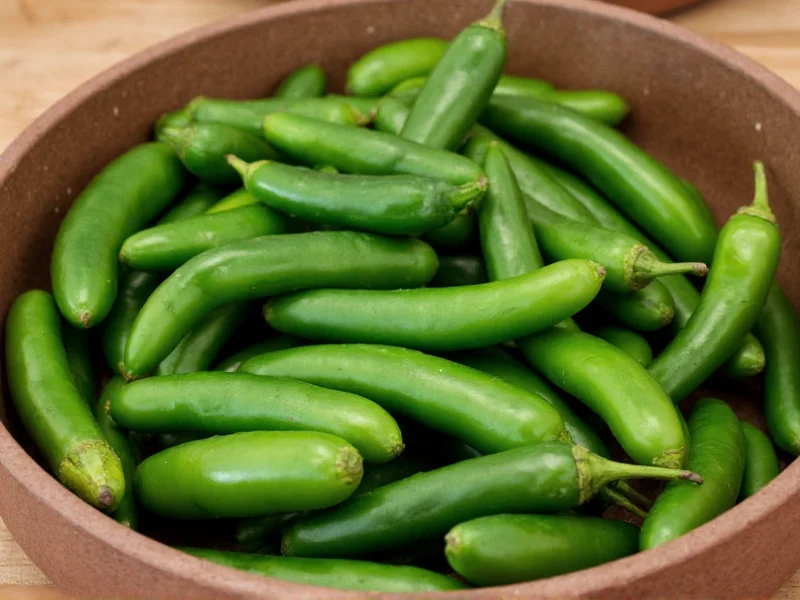When you order "jalapeños" at Chipotle, you're getting their signature pickled variety rather than fresh peppers. This preparation method serves multiple purposes for the fast-casual restaurant chain. The pickling process extends shelf life significantly compared to fresh jalapeños, which is crucial for a high-volume restaurant with consistent nationwide offerings. It also creates a uniform flavor profile and heat level across all locations, eliminating the natural variability found in fresh peppers.
What Exactly Are Chipotle's Jalapeños?
Chipotle's jalapeños undergo a specific preparation process before reaching your burrito. According to their official ingredients list, the complete formulation includes:
| Ingredient | Purpose |
|---|---|
| Jalapeño peppers | Main component providing capsaicin (heat) and flavor |
| Vinegar | Preservative and tangy flavor component |
| Water | Base liquid for the brine solution |
| Salt | Flavor enhancer and additional preservative |
| Calcium chloride | Crispness preserver (keeps peppers firm) |
Unlike fresh jalapeños that can vary dramatically in heat (measured in Scoville Heat Units), Chipotle's pickled version maintains a consistent medium spice level. The pickling process actually reduces the perceived heat while adding complexity through the vinegar tang. Most customers describe them as having a noticeable kick without being overwhelming—perfect for enhancing flavors without dominating the entire meal.
How Chipotle Prepares and Serves Their Jalapeños
At Chipotle locations, these pickled jalapeños arrive pre-prepared in large containers as part of their standardized ingredient system. Staff members simply scoop them from these containers into your order. The slicing is uniform—typically thin rounds that distribute evenly throughout your meal.
Interestingly, Chipotle doesn't offer fresh jalapeños as a standard menu option. Some customers mistakenly believe they're getting fresh peppers, but the distinctive tang confirms they're pickled. During peak hours, the consistent preparation of these jalapeños helps maintain service speed while ensuring every customer receives the same experience regardless of location.
Nutritional Profile and Dietary Considerations
For health-conscious diners wondering about chipotle jalapenos nutrition facts, a standard serving (about 15g) contains:
- Negligible calories (approximately 2-3 per serving)
- No fat content
- Minimal carbohydrates (less than 1g)
- No protein
- About 65mg sodium (primarily from the brine)
These nutritional characteristics make them suitable for most dietary restrictions. They're naturally gluten-free, vegan, and paleo-friendly. The primary consideration for sensitive individuals would be the sodium content from the brine solution, though this remains relatively low compared to many other condiments.
Customer Preferences and Usage Tips
Understanding what kind of jalapenos chipotle uses can help you customize your order effectively. Many regular customers have developed strategies for maximizing their jalapeño experience:
For those who enjoy extra heat, adding jalapeños to both the base of your bowl and on top creates layered spice distribution. If you're sensitive to spice but want the flavor, request "light jalapeños" which staff typically interpret as half the standard amount. Some customers combine jalapeños with Chipotle's house salsa for a customized heat level.
Contrary to popular belief, the heat doesn't significantly mellow when mixed with other ingredients. The vinegar base actually helps the capsaicin (the compound that creates heat) distribute more evenly throughout your meal rather than concentrating in specific bites.
How Chipotle's Jalapeños Compare to Fresh Varieties
When customers ask are chipotle jalapenos real, the answer is yes—but they're processed differently than what you'd find in a grocery store produce section. Fresh jalapeños typically range from 2,500 to 8,000 Scoville Heat Units, but their heat level varies significantly based on growing conditions, maturity, and even which part of the pepper you eat.
Chipotle's pickled version maintains a more consistent medium heat level around 3,000-4,000 SHU. The pickling process breaks down some capsaicin while adding the vinegar tang, creating what many describe as a more approachable heat. Food scientists note that the acid in vinegar can actually enhance our perception of certain flavor compounds while slightly reducing pure heat intensity.
Common Misconceptions About Chipotle's Jalapeños
Several myths persist about what are chipotle's jalapenos made of. Some customers believe they contain artificial flavors or colors, but the ingredient list confirms they use only natural components. Others speculate that Chipotle uses a special hybrid pepper, but they actually use standard jalapeño cultivars that have been selectively bred for consistent size and moderate heat.
One persistent question is whether chipotle jalapenos are fermented. While true fermentation involves microbial activity that creates lactic acid, Chipotle's version uses vinegar (acetic acid) for preservation, making them pickled rather than fermented. This distinction matters for those interested in probiotic benefits, as vinegar-based pickles don't contain the live cultures found in fermented foods.











 浙公网安备
33010002000092号
浙公网安备
33010002000092号 浙B2-20120091-4
浙B2-20120091-4